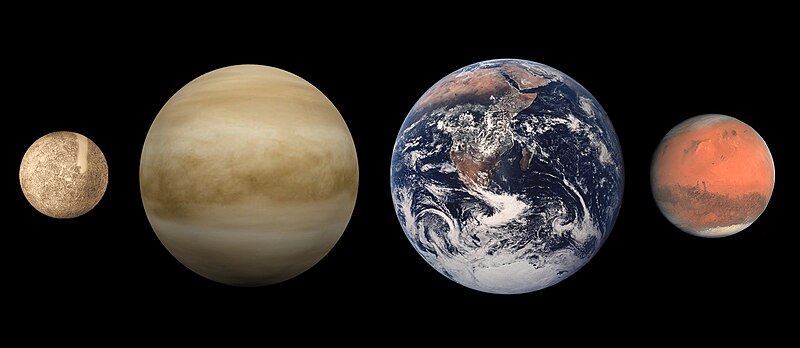Over the next few years, NASA will be sending amazing new missions to the planets in the inner solar system. The four planets in the inner solar system are Mercury, Venus, Earth, and Mars (in that order from the sun). A little further out from Mars is the asteroid belt, a zone containing thousands upon thousands of asteroids.
Some of these missions to the inner solar system include the first mission to the planet Mercury, brand new Earth observation satellites, an enormous robotic Mars lander, and a mission that will visit the two largest asteroids in the solar system. There is also some funding for Earth observatories to keep an eye out for near earth asteroids that could impact the Earth.
There are going to be many interesting discoveries in the next few years, but let's take a tour of what we presently know about the inner solar system.
The planets of the inner solar system in order (distance not to scale): Mercury, Venus, Earth, and Mars.
To go with its age Mercury even has wrinkles. These wrinkles were caused by Mercury contracting and cooling from when it first formed. The wrinkles were just found last year during one of the first flybys of Mercury by the Messenger probe, the first dedicated Mercury mission.
Since it is so close to the Sun, it has surface temperatures that can reach over 400°C but at night temperatures can drop to -180°C.
Mercury's year lasts only 88 Earth days while its "day" lasts about 59 Earth days.
The second planet from the Sun is Venus, which is also the hottest planet in our solar system. It is almost as big as the Earth and used to be thought of as Earth's twin and was thought to have oceans and life.
When probes were sent to Venus in the 1970's it was discovered that Venus was more of a hell than an Eden for life. The surface temperature is a scorching 460°C and has an atmosphere pressure 93 times greater than Earth's. That pressure is similar to diving one kilometre below the surface of an ocean. To top off this wonderful weather, it rains sulphuric acid!
One of the strangest things about Venus is the fact that it rotates in a direction different than the rest of the planets. This causes Venus' day to last longer than its year!
Venus is a very interesting world and is also the easiest planet to see from Earth. It appears as the second brightest object in the night sky, after our moon. It is so bright that people have mistaken it for an alien spacecraft of some sort.
The third rock from the Sun, the Earth, is the only planet known to contain life. Earth is also the largest rocky planet and the only world in the inner solar system with liquid on its surface.
Earth's moon is much larger than would be expected for a planet of Earth's size. The leading theory as to how the moon formed is that a Mars sized object impacted Earth four billion years ago and the ejected molten rock eventually came together to form the moon. For a few million years the Earth would have had rings just like Saturn!
Our planet's average temperature is 14°C but is on the increase because of global warming.
Moving on to the last of the inner planets is Mars, a small and chilly world that people may one day live on. Mars has ice caps made of frozen water and frozen carbon dioxide. The surface area of the red planet is roughly the same as Earth's land area.
Mars has had a very interesting and exciting past with huge floods that carved the biggest canyon in the solar system. Mars also has the tallest volcano, but it is no longer active. This monster volcano is 27 kilometres tall, or almost three times as tall as Mount Everest!
The average temperature on Mars is around -46°C, similar to a normal winter in Antarctica. When NASA is ready to send humans to Mars, they better bring a warm tuque!
While we're looking at the inner planets, let's see what's up in this month's skies.
The moon will be new on Mar. 15 and will swell to a full moon by Mar. 30.
An hour after sunset, Mars will be visible high in the southern sky. It will be a brilliant reddish-orange. Saturn will be rising in the East.
The first day of Spring is on Mar. 20 this year.
The monthly meeting of the Athena Community Astronomy Club is from 7pm to 9pm on the last Sunday of the month, Mar. 28.
Next month, we'll continue our tour of the solar system by taking a look at the outer solar system.
Until next month, just look up!
Hey Kids...
There is yet another space technology on the market: space underwear. Normally in the past, astronauts would wear clothes for a few days and since their is no laundromat in space, they would throw out the clothes. Japanese astronaut Koichi Wakata tried out some new space-age clothing material. He wore the same clothes for two months! The clothes eliminate odour, absorb water, dry quickly, are insulating, are anti-static, and are flame resistant. Space underwear is now on sale for $115 each.

No comments:
Post a Comment